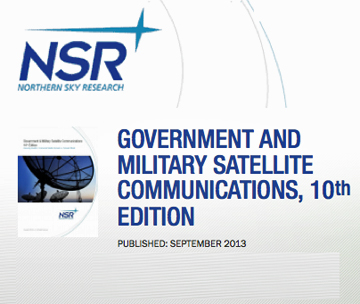But this tree is hiding a forest of not-so-good news that gives the impression the bottom of the MILSATCOM wave is yet to come for the satellite industry.
The U.S. Army awards in the last week of Fiscal Year 2013 to players such as AT&T, L-3, Globecomm Systems, Harris, General Dynamics were for a variety of communications and transmissions systems and left the impression of some reprieve from cuts. But these late-September awards are part of the annual frenzy of contracts to avoid funds from lapsing to prevent them being cut next year. Many governments around the world have this last-minute ‘spend-it-or-lose-it” mentality in public expenditures, which was more critical in the U.S. this year where everything is on the table to cut.
Behind this large award, however, reports of a strong backlash due to budget reductions, sequestration, troops pulling out of Afghanistan and now the U.S. Government shutdown have surfaced. Intelsat said it missed the late September shopping spree, and the operator is on track to lose a few percentage points off of its government business scorecard this year. Iridium and Inmarsat have both been impacted by the troop pull-outs, and all FSS and MSS operators have noted slower (if not negative) growth in government and military revenues.
Many project revenues in the short-term will probably decline, and the mid-term outlook looks somewhat fuzzy at best, but long-term the industry clearly echoes NSR’s recently released Government and Military Satellite Communications, 10th Edition report: the market for government and military satcom is here to stay. Even with lower usage in satellite capacity and cuts to prices for equipment and services over the next 12 to 18 months, this uncomfortable position overshadows some bright spots such as the mobility market, which continues to shine a light on commercial satcom with more capacity demand per unit for most platforms.
Operators such as SES have indicated higher levels of equipment sales to government customers in their revenues for the first half of 2013, which they attributed to their Government Solutions business unit’s solid performance of year-on-year revenue growth. In discussing the future of its relation with the commercial world, the Commander of the U.S. Air Force Space Command said key decisions to leverage commercial satellites via expanded transponder leases would come in 2015 or 2016. As for the long-awaited Pivot to Asia, the Commander of the Pacific Air Forces said at a recent conference that despite the slowdown in rebalancing to the area, his belief is that fiscal constraint today is no indication whatsoever of our long term commitment to the Asia-Pacific region.
Bottom Line
It may take a few years and, yes, there will be a pause in government spending such that many FSS and MSS markets will experience tough times in the near term. But due to its strategic importance in supporting worldwide operations, comsatcom will remain a key component of government and military communications network architectures with mobility and higher bandwidth remaining central to government satcom needs.
Information for this article was extracted from NSR's report: Government and Military Satellite Communications, 10th Edition and was authored by NSR's Senior Analyst, France, Mr. Claude Rousseau.


